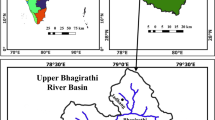Abstract
The urgent need for rational use of water resources and the intense competition among most of the riparian countries with respect to the use of shared water sources have raised the importance of examining the contribution of base flow to total stream flow. This paper examines the Diyala transboundary river basin shared between Iraq and Iran. Daily unregulated flow records during the hydrologic years between 1955 and 1982 were considered at the upstream flow gauging station and daily unimpaired flow time series during the water years between 1931 and 1961 were examined at the most downstream hydrometric station. Two digital filtering algorithms and the flow duration curve method were applied to extract the base flow time series and compute its signature to total river flow. A generic methodology, which incorporates the flow duration curve method within digital filtering algorithms, has been introduced to obtain the filter parameter α in the filtering algorithms, and obtain the base flow contribution with a high level of confidence. Findings revealed that the base flow proportion is 38 % for the upper sub-basin and 31 % for the upper and middle combined sub-basins. The computed base flow signatures using the incorporated approach have very strong correlation coefficients of around 0.985. The driest year had the highest annual base flow index. The base flow index values started to increase in April and climbed to a peak by the end of May. A gradual decline between August and September was observed. The proposed methodology should be applied to unregulated watersheds.







Similar content being viewed by others
References
Abebel A, Foerch G (2006) Catchment characteristics as predictors of baseflow index (BFI) in Wabi Shebele river basin, East Africa. Proceedings of the Conference on International Agricultural Research for Development. Tropentag 2006, University of Bonn, 11–13 October 2006. Bonn, Germany. http://www.tropentag.de/2006/abstracts/full/401.pdf. Accessed 24 March 2014
Ahiablame L, Chaubey I, Engel B, Cherkauer K, Merwade V (2012) Estimation of annual baseflow at ungauged sites in Indiana USA. J Hydrol 476:13–27
Al-Faraj FAM, Scholz M (2014) Assessment of temporal hydrologic anomalies coupled with drought impact for a transboundary river flow regime: the Diyala watershed case study. J Hydrol 517:64–73
Brodie RS, Hostetler S (2005) A review of techniques for analysing base-flow from stream hydrographs, Proceedings of the NZHS-IAH-NZSSS 2005 Conference, 28 November–2 December 2005, Auckland, New Zealand
Brušková V (2008) Assessment of the baseflow in the upper part of Torysa river catchment. Slovak J Civ Eng, 16:8-14. http://www.svf.stuba.sk/docs/sjce/2008/2008_2/file2.pdf. Accessed 24 March 2014
Eckhardt K (2005) How to construct recursive digital filters for base flow separation. Hydrol Proced 19:507–515
Gregor M (2010) BFI+3.0 version 3.0 Build 9 user’s manual. Hydro Office. http://hydrooffice.org. Accessed 22 March 2014
Haberlandt U, Klöckin B, Krysanova V, Becker A (2001) Regionalization of the baseflow index from dynamically simulated flow components: a case study in the Elbe River Basin. J Hydrol 248:35–53
Institute of Hydrology (1980) Low flow studies (1–4). Institute of Hydrology, Wallingford
Lim KJ, Engel BA, Tang Z, Choi J, Kim K-S, Muthukrishnan S, Tripathy D (2005) Automated web GIS based hydrograph analysis tool, WHAT. J Am Water Res Assoc 41:1407–1416
Lim KJ, Parka YS, Kima J, Shina Y-C, Kimb NW, Kimc SJ, Jeon J-H, Engel BA (2010) Development of genetic algorithm-based optimization module in WHAT system for hydrograph analysis and model application. Comp Geosci 36:936–944
Longobardi A, Villani P (2008) Baseflow index regionalization analysis in a Mediterranean area and data scarcity context: role of the catchment permeability index. J Hydrol 355:63–75
Price K (2011) Effects of watershed topography, soils, land use, and climate on base flow hydrology in humid regions: a review. Prog Phys Geogr 35:465–492
Shadeed S, Shaheen H, Jayyousi A (2007) Management options of wadi Faria base flow. Proceedings of the 11th international water technology conference. Mansoura University, Sharm El-Sheikh, pp 129–143
Singh A, Bürger CM, Cirpka AO (2013) Optimized sustainable groundwater extraction management: general approach and application to the City of Lucknow, India. Wat Res Manag 27:4349–4368
Smakhtin VU (2001) Estimating continuous monthly base flow time series and their possible applications in the context of the ecological reserve. Water SA 27:213–218
Stewart M, Cimino J, Ross M (2007) Calibration of base flow separation methods with streamflow conductivity. Groundwater 45:17–27
Tallasken LM, Van Lanen HAJ (2004) Hydrological groundwater development in water science. Elsevier, Amsterdam
Welderufael WA, Woyess YE (2010) Stream flow analysis and comparison of base flow separation methods: case study of the Modder River Basin in Central South Africa. Eur Water 31:3–12
WMO (2009) Manual of low-flow estimation and prediction, Operational Hydrology Report Number 50, World Meterological Organization (WMO) Report Number 1029, Report, WMO
Zhang Y, Ahiablame L, Engel B, Liu J (2013) Regression modeling of baseflow and baseflow index for Michigan USA. Water 5:1797–1815
Acknowledgments
The authors would like to express their gratitude to the General Directorate of Dams and Reservoirs, Derbandikhan Dam Directorate and the Ministry of Agriculture and Water Resources of the Kurdistan Regional Government in Iraq for their cooperation and facilitation in data provision.
Author information
Authors and Affiliations
Corresponding author
Rights and permissions
About this article
Cite this article
Al-Faraj, F.A.M., Scholz, M. Incorporation of the Flow Duration Curve Method Within Digital Filtering Algorithms to Estimate the Base Flow Contribution to Total Runoff. Water Resour Manage 28, 5477–5489 (2014). https://doi.org/10.1007/s11269-014-0816-7
Received:
Accepted:
Published:
Issue Date:
DOI: https://doi.org/10.1007/s11269-014-0816-7



